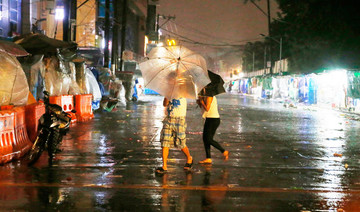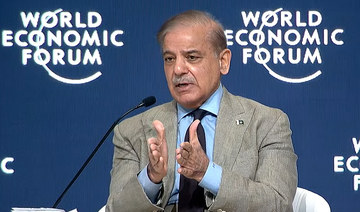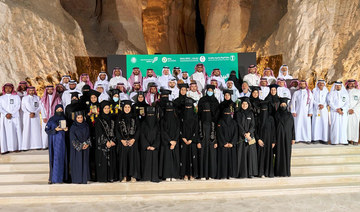TUGUEGARAO, Philippines: Typhoon Mangkhut roared toward densely populated Hong Kong and southern China on Sunday after ravaging across the northern Philippines with ferocious winds and heavy rain that left at least 28 dead in landslides and collapsed houses.
The strongest storm so far this year in the world sliced across the northern tip of Luzon Island on Saturday, a breadbasket that is also a region of flood-prone rice plains and mountain provinces with a history of deadly landslides. More than 5 million people were in the path of the typhoon, equivalent to a Category 5 Atlantic hurricane when it hit the Philippines. On Sunday morning, It packed sustained winds of 155 kilometers (96 miles) per hour and gusts of up to 190 kph (118 mph).
Hong Kong and southern China issued the highest storm signals. The Guangdong provincial office in charge of flood prevention said Sunday that nearly half a million people had been evacuated from seven cities.
The Hong Kong Observatory said although Mangkhut had weakened slightly, its extensive, intense rainbands were bringing heavy downfall and frequent squalls. Storm surge of about 3 ½ meters (9.8 feet) or above is expected at the city’s waterfront Victoria Harbor, the observatory said, appealing on the public to avoid the shoreline.
Philippine National Police Director General Oscar Albayalde told The Associated Press that 20 had died in the Cordillera mountain region, four in nearby Nueva Vizcaya province and another outside of the two regions. Three more deaths have been reported in northeastern Cagayan province, where the typhoon made landfall.
Among the fatalities were an infant and a 2-year-old child who died with their parents after the couple refused to immediately evacuate from their high-risk community in a Nueva Vizcaya mountain town, said Francis Tolentino, an adviser to Philippine President Rodrigo Duterte.
“They can’t decide for themselves where to go,” he said of the children, expressing frustration that the tragedy was not prevented.
Tolentino, who was assigned by Duterte to help coordinate disaster response, said at least two other people were missing.
Mayor Mauricio Domogan said at least three people died and six others were missing in his mountain city of Baguio after strong winds and rain destroyed several houses and set off landslides, which also blocked roads to the popular vacation destination. It was not immediately clear whether the dead and missing had been included in the overall death toll.
About 87,000 people had evacuated from high-risk areas of the Philippines. Tolentino and other officials advised them not to return home until the lingering danger had passed.
In Cagayan’s capital, Tuguegarao, where the typhoon made landfall, Associated Press journalists saw a severely damaged public market, its roof ripped apart and wooden stalls and tarpaulin canopies in disarray. Outside a popular shopping mall, debris was scattered everywhere and government workers cleared roads of fallen trees. Many stores and houses were damaged but most residents remained indoors as occasional gusts sent small pieces of tin sheets and other debris flying dangerously.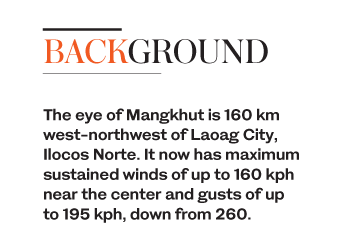
The Tuguegarao airport terminal also was damaged, its roof and glass windows shattered by strong winds.
The typhoon struck at the start of the rice and corn harvesting season in Cagayan, a major agricultural producer, prompting farmers to scramble to save what they could of their crops, Cagayan Gov. Manuel Mamba said.
In Hong Kong, Security Minister John Lee Ka-chiu urged residents to prepare for the worst.
Cathay Pacific said all of its flights would be canceled between 2:30 a.m. local time on Sunday and 4 a.m. Monday.
“Because Mangkhut will bring winds and rains of extraordinary speeds, scope and severity, our preparation and response efforts will be greater than in the past,” Lee said. “Each department must have a sense of crisis, make a comprehensive assessment and plan, and prepare for the worst.”
In nearby Fujian province in China, 51,000 people were evacuated from fishing boats and around 11,000 vessels returned to port.
China’s National Meteorological Center issued an alert saying Mangkhut would make landfall somewhere on the coast in Guangdong province on Sunday afternoon or evening.
Ferry services in the Qiongzhou Strait in southern China were halted on Saturday and helicopters and tugboats were dispatched to Guangdong to transfer offshore workers to safety and warn ships about the typhoon, China’s official Xinhua News Agency reported.
Mangkhut, the Thai word for mangosteen fruit, is the 15th storm this year to batter the Philippines, which is hit by about 20 a year and is considered one of the world’s most disaster-prone countries. In 2013, Typhoon Haiyan left more than 7,300 people dead or missing, flattened villages, swept ships inland and displaced more than 5 million in the central Philippines.
Typhoon death toll in Philippines jumps to 28
Typhoon death toll in Philippines jumps to 28
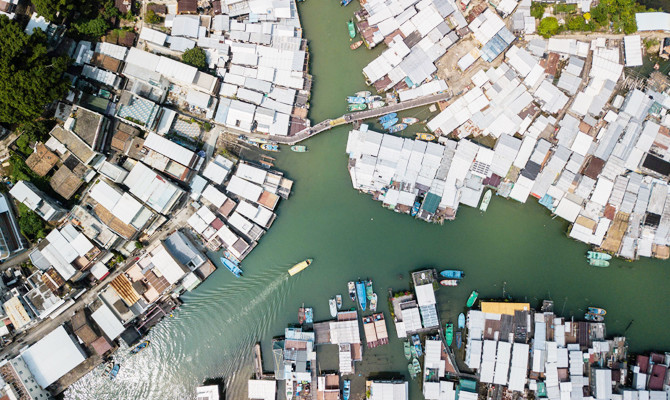
- Storm warnings remained hoisted in 10 northern provinces, including Cagayan, which could still be lashed by devastating winds
- Tuguegarao airport terminal was badly damaged, its roof and glass windows shattered by strong wind, which also sent chairs, tables and papers flipping about inside
Saudi crown prince receives world officials after WEF special meeting in Riyadh
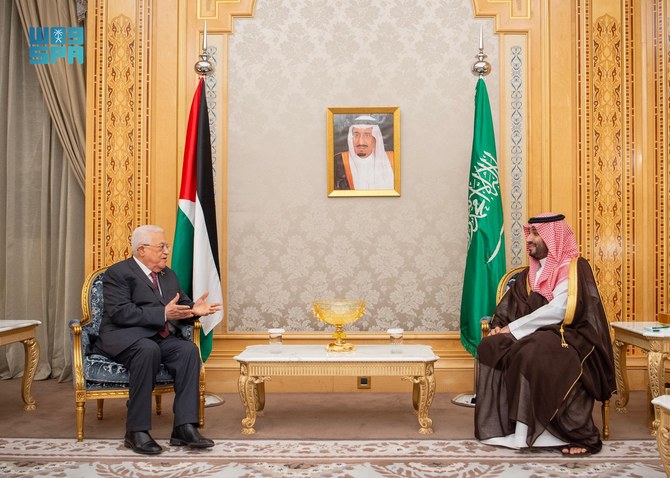
RIYADH: Saudi Crown Prince Mohammed bin Salman received officials from around the world in Riyadh after a special meeting of the World Economic forum ended on Monday.
The officials included Palestinian President Mahmoud Abbas, US Secretary of State Antony Blinken, British Foreign Secretary David Cameron, the Prime Minister of Malaysia Anwar Ibrahim, and the Prime Minister of Pakistan Shehbaz Sharif.
The officials attended the two-day special meeting during which the crown prince called for global collaboration to help build a more resilient and integrated global economy.
Blinken is visiting the Kingdom on his seventh trip to the Middle East since the Oct. 7 Hamas attack on Israel, which responded with a relentless offensive in Gaza that has drawn global criticism.
Libya demands improvements after leaked photos show tiny cell of Muammar Qaddafi’s son in Beirut
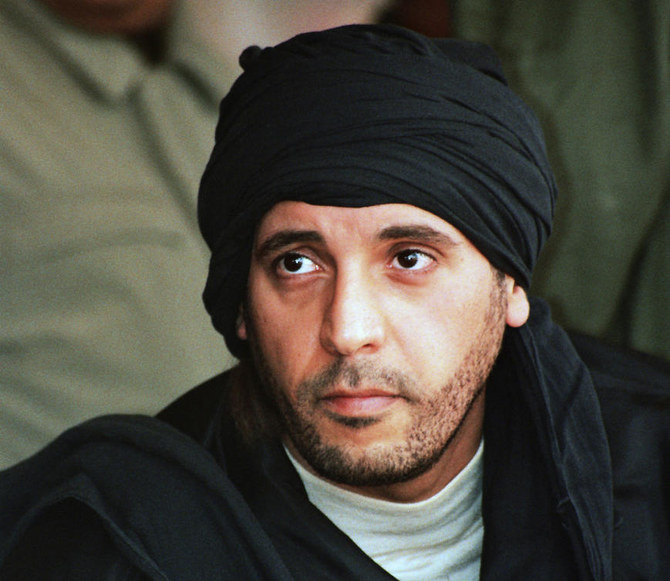
- Hannibal Qaddafi has been held in Lebanon since 2015 after he was kidnapped from neighboring Syria
- Qaddafi was abducted by Lebanese militants demanding information about the fate of prominent Lebanese Shiite cleric Moussa Al-Sadr
The photos showed a room without natural light packed with Hannibal Qaddafi’s belongings, a bed and a tiny toilet. “I live in misery,” local Al-Jadeed TV quoted the detainee as saying in a Saturday evening broadcast, adding that he is a political prisoner in a case he has no information about.
Two Lebanese judicial officials confirmed to The Associated Press on Monday that the photographs aired by Al-Jadeed are of Qaddafi and the cell where he has been held for years at police headquarters in Beirut. Qaddafi appeared healthy, with a light beard and glasses.
A person who is usually in contact with Qaddafi, a Libyan citizen, said the photos were taken in recent days. All spoke on condition of anonymity because they were not authorized to speak to media outlets.
Qaddafi has been held in Lebanon since 2015 after he was kidnapped from neighboring Syria, where he had been living as a political refugee. He was abducted by Lebanese militants demanding information about the fate of prominent Lebanese Shiite cleric Moussa Al-Sadr, who went missing during a trip to Libya in 1978.
The fate of Al-Sadr has been a sore point in Lebanon. His family believes he may still be alive in a Libyan prison, though most Lebanese presume Al-Sadr, who would be 95 now, is dead.
A Libyan delegation visited Beirut in January to reopen talks with Lebanese officials on the fate of Al-Sadr and the release of Qaddafi. The talks were aimed at reactivating a dormant agreement between Lebanon and Libya, struck in 2014, for cooperation in the probe of Al-Sadr. The delegation did not return to Beirut as planned.
The leaks by Al-Jadeed came after reports that Qaddafi was receiving special treatment at police headquarters and that he had cosmetic surgeries including hair transplants and teeth improvements. Al-Jadeed quoted him as saying: “Let them take my hair and teeth and give me my freedom.”
Qaddafi went on a hunger strike in June last year and was taken to a hospital after his health deteriorated.
Libya’s Justice Ministry in a statement Sunday said Qaddafi is being deprived of his rights guaranteed by law. It called on Lebanese authorities to improve his living conditions to one that “preserves his dignity,” adding that Lebanese authorities should formally inform the ministry of the improvements. It also said Qaddafi deserves to be released.
After he was kidnapped in 2015, Lebanese authorities freed him but then detained him, accusing him of concealing information about Al-Sadr’s disappearance.
Al-Sadr was the founder of the Amal group, a Shiite militia that fought in Lebanon’s 1975-90 civil war and later became a political party that is currently led by the country’s Parliament Speaker Nabih Berri.
Many of Al-Sadr’s followers are convinced that Muammar Qaddafi ordered Al-Sadr killed in a dispute over Libyan payments to Lebanese militias. Libya has maintained that the cleric, along with two traveling companions, left Tripoli in 1978 on a flight to Rome.
Human Rights Watch issued a statement in January calling for Qaddafi’s release. The rights group noted that Qaddafi was only 2 years old at the time of Al-Sadr’s disappearance and held no senior position in Libya as an adult.
IMF approves $1.1 billion funding for Pakistan
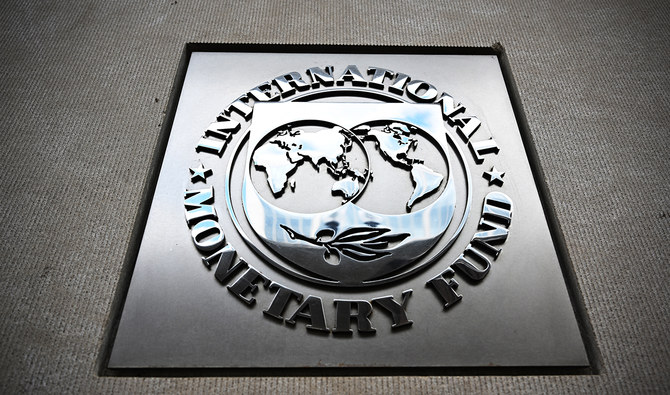
- The funding is the final tranche of a $3 billion standby arrangement Islamabad secured last year
- Islamabad is now seeking a new, larger long-term Extended Fund Facility agreement with the IMF
ISLAMABAD: The executive board of the International Monetary Fund approved $1.1 billion in funding for Pakistan on Monday, the agency said in a statement, amid discussions for a new loan.
The funding is the second and last tranche of a $3 billion standby arrangement with the IMF, which Islamabad secured last summer to help avert a sovereign default.
The approval came a day after Pakistan Prime Minister Shehbaz Sharif discussed a new loan program with IMF Managing Director Kristalina Georgieva on the sidelines of the World Economic Forum in Riyadh.
Islamabad is seeking a new, larger long-term Extended Fund Facility (EFF) agreement with the fund after the current standby arrangement expires this month. Pakistan’s Finance Minister, Muhammad Aurangzeb, has said Islamabad could secure a staff-level agreement on the new program by early July.
Islamabad says it is seeking a loan over at least three years to help achieve macroeconomic stability and execute long-overdue and painful structural reforms.
Aurangzeb has declined to give details on the amount the country is seeking.
Islamabad is yet to make a formal request, but the Fund and the government are already in discussions.
If secured, it would be Pakistan’s 24th IMF bailout.
The $350 billion economy faces a chronic balance of payments crisis, with nearly $24 billion to repay in debt and interest over the next fiscal year — three-time more than its central bank’s foreign currency reserves.
What We Are Reading Today: A Deadly Indifference
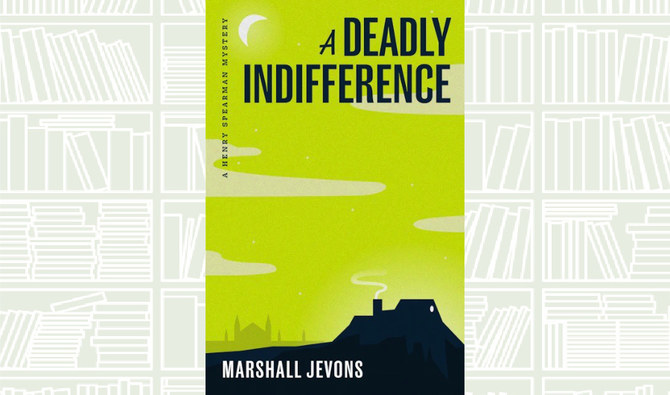
Author: Marshall Jevons
Harvard professor Henry Spearman—an ingenious amateur sleuth who uses economics to size up every situation—is sent by an American entrepreneur to Cambridge, England.
Spearman’s mission is to scout out the purchase of the most famous house in economic science: Balliol Croft, the former home of Professor Alfred Marshall, John Maynard Keynes’s teacher and the font of modern economic theory.
After a shocking murder, Spearman realizes that his own life is in danger as he finds himself face-to-face with the most diabolical killer in his career.
Saudi Arabia, UNEP launch World Environment Day campaigns
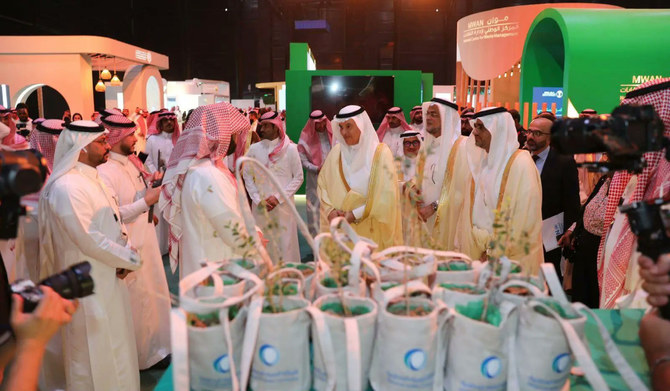
- Faqeeha noted that on the occasion of World Environment Day, Saudi Arabia will shed light on the urgent need for global investments in conserving nature, restoring lands, and working toward sustainability
RIYADH: Saudi Arabia and the UN Environment Programme have announced campaigns to combat desertification, restore ecosystems, and strengthen drought resilience ahead of World Environment Day celebrations on June 5 in Riyadh.
The announcement was made at the opening of Saudi Arabia’s Environment Week on Sunday, the Saudi Press Agency reported.
Saudi Minister of Environment, Water, and Agriculture Abdulrahman Al-Fadhli inaugurated the annual event that aspires to raise awareness of the importance of environmental protection.

During the event, Deputy Minister for Environment Osama Faqeeha emphasized the shared responsibility in addressing land degradation and combating desertification. This responsibility extends to policymakers, the private sector, and civil society organizations globally, who must work together to restore agricultural areas, rehabilitate land, and tackle desertification and drought, he said.
Faqeeha noted that on the occasion of World Environment Day, Saudi Arabia will shed light on the urgent need for global investments in conserving nature, restoring lands, and working toward sustainability.
This year, we are calling on people — from the grassroots to governments — to help tackle the climate and extinction crisis we face by restoring the ground we depend on for survival.
Elizabeth Mrema, Deputy executive director, UNEP
He highlighted the importance of uniting national and international efforts to safeguard and rehabilitate ecosystems across the globe, aiming to fulfill sustainable development objectives.
“Without action, 95 percent of land on Earth could be degraded within the next 30 years, which could spell disaster for humanity and the planet,” said Elizabeth Mrema, deputy executive director of UNEP, launching the global campaign at a Saudi Environment Week event in Riyadh.
“We have seen how previous campaigns have catalyzed climate action across the globe. This year, we are calling on people — from the grassroots to governments — to help tackle the climate and extinction crisis we face by restoring the ground we depend on for survival,” she added.
Countries worldwide have committed to restoring 1 billion hectares of land, aiming to protect 30 percent of land and sea for nature and restoring 30 percent of the planet’s degraded ecosystems.
Supporting the UN 2030 Agenda for Sustainable Development, World Environment Day 2024 will boost climate action efforts by gathering support for ecosystem restoration.
At the opening event of the Saudi Environment Week, Al-Fadhli emphasized that achieving the goals of environmental protection and conservation of the Kingdom’s natural resources requires active engagement from governmental and private sectors, as well as individuals.
He stressed the significance of adopting eco-friendly behaviors in daily routines and applying these practices across different sectors to reach sustainable development objectives.
“The continuation of this national event annually in the Kingdom reflects our wise leadership’s dedication to environmental protection and commitment to sustainable development, in line with the goals of Saudi Vision 2030,” Al-Fadhli said.
“Moreover, the Kingdom’s dedication to environmental protection is evident at national, regional, and international levels. This is demonstrated by Saudi Arabia’s active participation in numerous environmental agreements and organizations, as well as its … initiatives like the Middle East Green Initiative and other significant global environmental efforts under the G20 umbrella,” he added.



